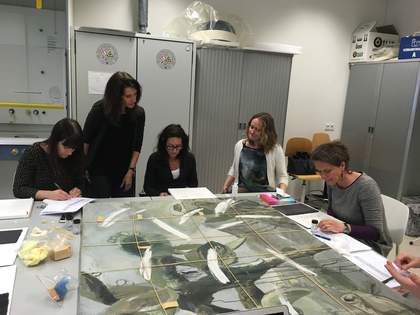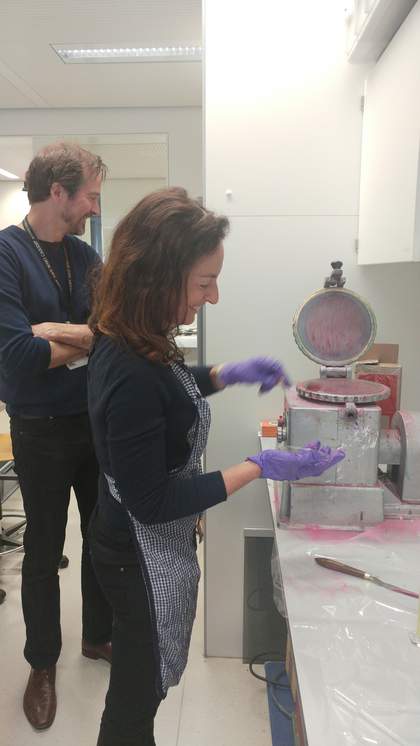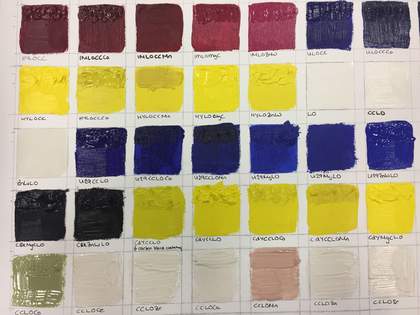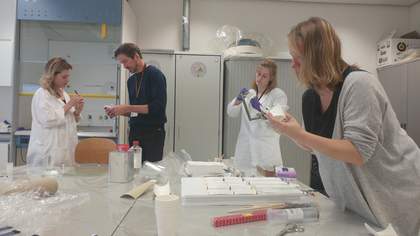In April 2017, two CMOP workshops were arranged at the Ateliergebouw in Amsterdam.1 The workshops included most of the CMOP core members as well as associated partners from the Stedelijk Museum Amsterdam and Gemeentemuseum in the Hague. The first workshop involved a review of the current methodologies commonly used for surface cleaning twentieth century unvarnished water sensitive oil paintings. Recent research activities carried out as part of CMOP were discussed, and finally there was an opportunity to try out some of the cleaning materials currently available to conservators on test paint substrates.
Based on a series of interviews with paintings conservators and a recent literature survey Judith Lee (Conservation Science Postdoctoral Researcher, Tate/CMOP) and Lise Steyn (PhD candidate, University of Amsterdam/CMOP) determined that conservators currently tend to rely on dry cleaning methods for cleaning water sensitive oil paintings.2 Depending on the surface in question dry cleaning methods may include the use of brushes, smoke sponges or proprietary materials such as Groom/Stick molecular trap. Whilst these methods may help to remove loose or particulate surface dirt they are not always effective for the removal of surface dirt which on unvarnished surfaces can become intimately bound to the painted surface.

Fig.1: Judith Lee, Bronwyn Ormsby, Aviva Burnstock, Ilaria Bonaduce and Maartje Stols-Witlox conduct and document cleaning tests on a test-painting
This highlights the need for development and careful evaluation of cleaning materials and methodologies specifically tailored for use on water sensitive oil paintings. This is one of the key objectives of the CMOP project. The evaluation of cleaning materials for possible use on paintings involves making sure that there are no interactions with the paint surface that might cause unwanted changes such as changes in colour or gloss. Additionally it is important that residues from the cleaning system are not left behind on the paint surface. Examples of analytical techniques that enable the study of the paint surface before and after cleaning include Scanning Electron Microscopy (SEM), Attenuated Total Reflectance Fourier Transform Infrared Spectroscopy (ATR-FTIR) and X-ray photoelectron spectroscopy (XPS).
The workshop continued with research updates. Dr Bronwyn Ormsby presented recent research regarding the application of microemulsions for removal of surface dirt from painted surfaces.3 A recent study describing the application of materials and methods originally developed for cleaning acrylic paintings for use on oil paintings was also discussed.4 Dr Katrien Keune (Senior Conservation Scientist, Rijksmuseum Amsterdam) and Lambert Baaij (PhD candidate, University of Amsterdam/Rijksmuseum) presented research on solvent-diffusion studies (looking at how quickly solvents can travel through a paint film). Finally research which has focussed on the cleaning of vulnerable underbound paint surfaces using materials being developed and evaluated as part of the Nanorestart project was presented.
Following the research updates and trials using mock-up samples, the CMOP workshop team carried out cleaning tests using a range of aqueous, solvent-based, gel and microemulsion systems on a naturally aged test painting produced in the 1980s. This workshop proved useful to all participants, not only by providing the opportunity to become familiar with the range of materials used, but it also provided an opportunity for reflection on the cleaning-related research carried out to date, and facilitated ongoing collaboration between CMOP partners for upcoming and continuing cleaning studies.

Fig.2 Klaas Jan van den Berg and Aviva Burnstock making paint using the paint mill.
The second workshop focussed on making oil paints using raw materials in order to investigate the relationship between modern oil paint formulation and paint degradation. A small paint mill was used to combine a variety of pigments, extenders (including magnesium carbonate and calcium carbonate) and linseed oil. Selected paint driers were also added to some of the paints; driers are additives included in paint formulations to promote oxidation and crosslinking.5 When used alone and/or in excess some driers such as cobalt driers can cause interesting effects such as wrinkling of the paint surface. This was seen in some of the paint samples a few hours after they were painted out.6

Fig.3 Paints made from raw materials using the paint mill and painted out on a canvas.
Samples were created using commercially prepared artists’ oil colours in order to investigate their drying and ageing behaviour. Paints of various brands were painted out unmodified from the manufacturers supplied tubes as a control set of samples. The tube colours were then modified by adding additional linseed oil to make the paints more medium rich; this may result in the formation of ‘medium skins’ that are often associated with water sensitive oil paints.7 In order to create underbound paints, tube colours were diluted using solvents and also modified by leaching out the binding medium by squeezing the tube paint onto absorbent tissue before painting out. These samples will mimic some of the characteristics of vulnerable and water sensitive oil paint encountered on paintings and will be a valuable resource for future study.

Fig.4 Lise Steyn and Klaas Jan van den Berg labelling samples. Melissa Daugherty and Ilaria Bonaduce preparing the film caster to create paint outs of commercial oil paints.
By the end of the workshop over two hundred model paints were produced. The reconstructions were allowed to dry and some samples were selected for artificial ageing, typically carried out through exposure to light at elevated lux levels, and controlled temperature and relative humidity conditions. The paint-outs are expected to become a rich source of samples for future studies that will develop the current understanding of the ageing and degradation behaviour of modern oil paint. Ultimately this research will help to inform the care and conservation of twentieth century oil paintings.
Lise Steyn, University of Amsterdam
May 2017
